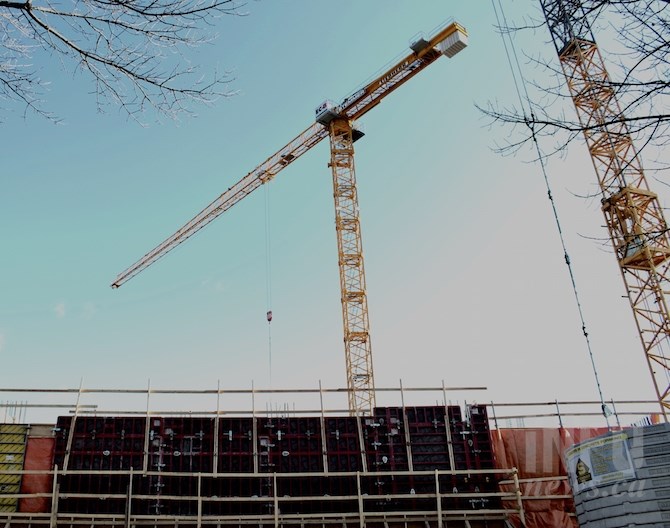
(ROB MUNRO / iNFOnews.ca)
April 24, 2023 - 11:00 AM
In real estate, the old adage is that it’s all about location, location, location.
For the Southern Interior construction industry, it’s all about government, government, government and numerous issues making them difficult to deal with, like getting paid on time.
“One is prompt payment legislation,” Cliff Kshyk, CEO of the Southern Interior Construction Association, told iNFOnews.ca. “For some reason the BC government is lagging in putting forward some legislation for prompt payment.”
While slow payments are not new, a survey put out this week by the B.C. Construction Association found that, for small companies, 29% were paid late at least 25% of the time. That grew to 43% for large companies.
Kshyk defined late payment as 30 to 45 days after the job is finished.
Ontario introduced such legislation in 2019. It sets tight timelines to submit invoices and appeals. If those are disputed, it goes to an adjudicator. Other provinces have similar legislation or are in the process of putting it in place.
In BC, a lien can be filed by the contractor against the property but, if that doesn’t budge the reticent customer, it has to go to court.
In the meantime, the construction companies are stuck with growing debts in a high interest world.
READ MORE: Hundreds of new homes on the way to Penticton
The second government issue is the permitting process at the provincial and municipal levels.
“The time that it takes to get a permit and the bureaucracy that is involved in getting a permit, really delays projects whether it’s an affordable home project or whether it’s a commercial project or just a residential building,” Kshyk said. “There are some municipalities who are pretty decent and efficient in the processing of permits. Others, it can take up to two years to get a permit.”
The City of Kelowna has a good reputation amongst his members while others, like Lake Country, do not.
“The biggest hindrances to building housing and other infrastructure today are the associated operations of the authorities having jurisdiction, from Crowns to ministries and municipalities,” B.C. Construction Association president Chris Atchison wrote in a report on the survey.
READ MORE: Single mom in Kamloops separated from babies for lack of affordable housing
The third big challenge for the industry indicated in the survey is labour which is also, in part, down to government.
“Because of the skilled labour shortage, we’re not finding the government, provincial or federal, are really acting effectively to streamline the process for bringing in skilled labour,” Kshyk said.
The survey found that the number of employees in the industry has grown by 17% year-over-year to 251,000 and is 6% above pre-pandemic levels.
But the skilled trades have declined by 4% year-over-year to 163,900 and by 9% compared to pre-pandemic levels.
“This de-skilling of the overall workforce reflects that it takes four years to complete an apprenticeship and may be fueling and increasing concern about safety on the worksite from survey respondents,” the report says.
“One of the most disappointing trends this year is the 21% decrease in tradeswomen, a sharp reversal after several years of solid gains,” it goes on to say. “Women comprise only 4.5% of the 163,900 skilled tradespeople in BC’s construction industry today, down from 6% in 2020.”
This comes despite years of trying to change the “old boys club” culture the industry used to carry, Kshyk said.
“There are companies that nurture diversity in the workplace,” he said. “Other companies are struggling.”
The whole industry is struggling with recruitment as more and more older workers retire.
“Nobody seems to want to get their hands dirty anymore,” Kshyk said. “I think that is really the thing. A lot of young people just want to be YouTubers and celebrities. It’s a much different world. People don’t want to work hard anymore.”
Despite this, the labour shortage has eased in the past five years, the report says.
“Young people also want to be involved with a purposeful career,” Kshyk said. “We have to show them how construction can be very purposeful and fulfilling.
“When you build a hospital, what does that hospital provide for the community? To be able to drive by a condo, with your kids, and say I helped all those families put a roof over their heads. It’s a matter of changing the image of the construction industry. You are part of something bigger than just sitting on a computer.”
To contact a reporter for this story, email Rob Munro or call 250-808-0143 or email the editor. You can also submit photos, videos or news tips to the newsroom and be entered to win a monthly prize draw.
We welcome your comments and opinions on our stories but play nice. We won't censor or delete comments unless they contain off-topic statements or links, unnecessary vulgarity, false facts, spam or obviously fake profiles. If you have any concerns about what you see in comments, email the editor in the link above.
News from © iNFOnews, 2023